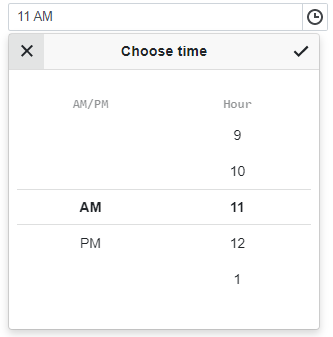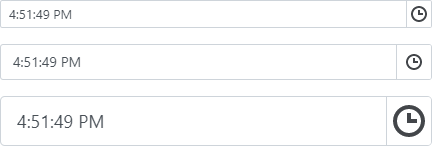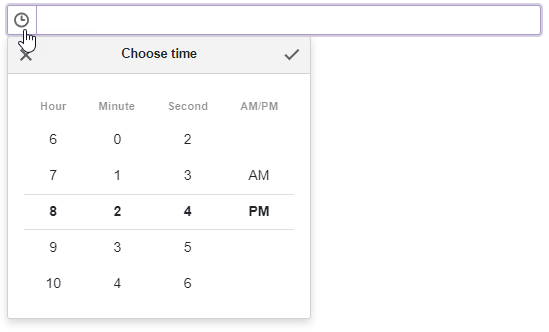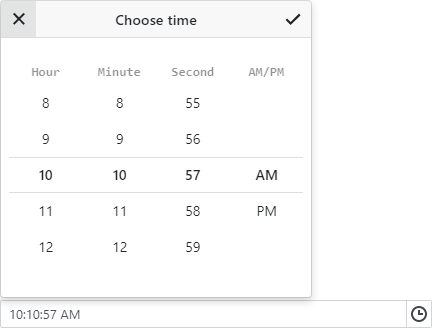DxTimeEdit<T> Class
A time editor with a drop-down time picker.
Namespace: DevExpress.Blazor
Assembly: DevExpress.Blazor.v23.2.dll
NuGet Package: DevExpress.Blazor
Declaration
public class DxTimeEdit<T> :
DxMaskedInputBase<T>,
IDropDownOwner,
IFocusableEditorType Parameters
| Name | Description |
|---|---|
| T | The data type. Supported types: DateTime, Nullable DateTime, TimeSpan, and Nullable TimeSpan. |
Remarks
The DevExpress Time Edit for Blazor (<DxTimeEdit>) displays a drop-down time picker. A user can enter the time into the text box or pick it in the drop-down window.

The component’s appearance depends on the current culture. If the culture does not use a 12-hour time format, time values are in 24-hour format and the drop-down window’s AM/PM column is not displayed.
Add a Time Edit to a Project
Follow the steps below to add the Time Edit component to an application:
- Use a DevExpress Project Template to create a new Blazor Server or Blazor WebAssembly application. If you use a Microsoft project template or already have a Blazor project, configure your project to incorporate DevExpress Blazor components.
- Add the
<DxTimeEdit>…</DxTimeEdit>markup to a.razorfile. - Configure the component: specify the editor’s value, apply a mask, add a clear button and placeholder, and so on (see the sections below).
Edit Value
Use the Time property to specify or read the control’s edit value. To limit the value range, use the MinTime and MaxTime properties. Refer to the following section for details: Set a Time Range.
You can use the @bind attribute to bind the Time property to a data field. Refer to the following help topic for details: Two-Way Data Binding.
<DxTimeEdit @bind-Time="@TimeValue" ></DxTimeEdit>
@code {
TimeSpan TimeValue { get; set; } = DateTime.Now.TimeOfDay;
}
If you do not use two-way binding, handle the TimeChanged event to respond to the editor’s time change. The code below enables the Update Time button if the specified value differs from the system time.
<DxTimeEdit Time="@Time"
TimeChanged="@((TimeSpan newValue) => OnTimeChanged(newValue))">
</DxTimeEdit>
<button type="button" class="btn btn-primary" disabled="@IsDisabled">Update Time</button>
@code {
TimeSpan Time = DateTime.Now.TimeOfDay;
bool IsDisabled = true;
void OnTimeChanged(TimeSpan newValue) {
Time = newValue;
if (newValue != DateTime.Now.TimeOfDay)
IsDisabled = false;
else IsDisabled = true;
}
}
Apply a Mask
The Time Edit component supports date-time masks. Apply a date-time mask to the component to display its value in a specific time format. Users can navigate between mask sections (such as hours, minutes, and seconds) and increase/decrease section values with the Up and Down arrow keys and mouse wheel.

Assign a predefined or custom pattern to the Mask property to apply a mask. To customize mask settings, add the DxDateTimeMaskProperties component to the Time Edit markup.
The example below demonstrates how to apply a date-time mask:
<DxTimeEdit @bind-Time="@Time"
Mask="@DateTimeMask.ShortTime">
<DxDateTimeMaskProperties CaretMode="@MaskCaretMode.Advancing" />
</DxTimeEdit>
@code {
DateTime Time { get; set; } = DateTime.Now;
}
Null Time Values and Placeholder
If the Time Edit component is bound to a nullable DateTime or TimeSpan object, users can delete the editor’s value (set it to null).
You can also set the ClearButtonDisplayMode property to Auto to show the Clear button when the editor has a non-null value. Use the NullText property to specify the prompt text (placeholder) when the editor’s value is null.
<DxTimeEdit @bind-Time="@TimeValue"
ClearButtonDisplayMode="DataEditorClearButtonDisplayMode.Auto"
NullText="Select time...">
</DxTimeEdit>
@code {
TimeSpan? TimeValue { get; set; } = DateTime.Now.TimeOfDay;
}

Time Format
Use the following properties to specify a value format:
- Format
- Applies the same time format in display and edit modes.
- DisplayFormat
- Specifies the time format in display mode.
See the Standard Date and Time Format Strings and Custom Date and Time Format Strings MSDN articles for more information about supported formats.
The following example demonstrates how to apply the a 12-hour clock format in display mode and the a 24-hour clock format in edit mode:
<DxTimeEdit @bind-Time="@TimeValue"
Format="HH:mm"
DisplayFormat="@DisplayFormat"></DxTimeEdit>
@code {
TimeSpan TimeValue { get; set; } = DateTime.Now.TimeOfDay;
string DisplayFormat { get; } = string.IsNullOrEmpty(System.Globalization.CultureInfo.CurrentCulture.DateTimeFormat.AMDesignator) ? "HH:mm" : "h:mm tt";
}

You can also specify Time Edit’s scroll picker format. Use the ScrollPickerFormat property to do this.
<DxTimeEdit @bind-Time="TimeValue" ScrollPickerFormat="tt hh" Format="hh tt" />
@code {
TimeSpan? TimeValue { get; set; } = DateTime.Now.TimeOfDay;
}

Set a Time Range
Use the MinTime and MaxTime properties to specify a range of available time values. The Time Edit’s time picker disables times outside the range.
The default minimum and maximum values are System.DateTime.MinValue and System.DateTime.MaxValue. Custom values should meet the following criteria:
- MaxTime is greater than MinTime.
- MaxTime is less than 24 hours.
- MinTime is greater than or equal to zero.
Note
- If a user types a value that is out of the range, the Time Edit keeps the previously selected time.
- The Time Edit shows a notification message each time a user tries to navigate to a time value that is out of the range. To customize the notification text, use the OutOfRangeNotificationText property.
- You can set the Time property to a time outside the range. In this case, the Time Edit shows this specified time, and the Time Edit’s picker displays the closest available time.
The code below implements the Time Edit component that allows users to select time from the current hour.
<DxTimeEdit @bind-Time="@TimeValue"
MinTime="@MinTime"
MaxTime="@MaxTime">
</DxTimeEdit>
@code {
TimeSpan TimeValue { get; set; } = DateTime.Now.TimeOfDay;
TimeSpan MinTime { get; set; }
TimeSpan MaxTime { get; set; }
protected override void OnInitialized() {
MinTime = new TimeSpan(TimeValue.Hours, 0, 0);
MaxTime = new TimeSpan(TimeValue.Hours, 59, 59);
}
}

Appearance Customization
Use the SizeMode property to specify a Time Edit size. The code below applies different size modes to Time Edit components.
<DxTimeEdit @bind-Time="@TimeValue" SizeMode="SizeMode.Small"></DxTimeEdit>
<DxTimeEdit @bind-Time="@TimeValue" SizeMode="SizeMode.Medium"></DxTimeEdit>
<DxTimeEdit @bind-Time="@TimeValue" SizeMode="SizeMode.Large"></DxTimeEdit>
@code {
TimeSpan TimeValue { get; set; } = DateTime.Now.TimeOfDay;
}

To customize Time Edit input, use the InputCssClass property. The following code snippet applies several CSS rules to the input:
<style>
.my-style {
height: 50px;
background: orange;
font-weight: 800;
}
</style>
<DxTimeEdit Time="DateTime.Now" InputCssClass="my-style"></DxTimeEdit>

For more information, refer to the following help topics:
Hide Built-In Drop-Down Button
Set the ShowDropDownButton to false to hide the built-in button that invokes a drop-down time picker. If you need a custom drop-down button, you can add a new command button.
Add Command Buttons
You can add custom command buttons to the Time Edit component. Refer to Command Buttons for more information.
The code below hides the built-in drop-down button, adds a new drop-down button, and specifies its position.
<DxTimeEdit Time="DateTime.Today.TimeOfDay" ShowDropDownButton=false>
<Buttons>
<DxTimeEditDropDownButton Position="EditorButtonPosition.Left"/>
</Buttons>
</DxTimeEdit>

Input Validation
You can add a standalone Time Edit or a Form Layout to the Blazor’s standard EditForm. This form validates user input and informs users of errors. Use the model’s data annotation attributes to specify input restrictions.
<EditForm Model="@starship" Context="EditFormContext">
<DataAnnotationsValidator />
<DxFormLayout >
<DxFormLayoutItem Caption="Time:" ColSpanMd="6" >
<Template >
<DxTimeEdit @bind-Time="@starship.Time" />
</Template>
</DxFormLayoutItem>
@*...*@
</DxFormLayout>
</EditForm>
@code {
private Starship starship=new Starship();
}
For more information, refer to the following help topic: Validate Input.
Drop-Down Window Direction
Use the DropDownDirection property to specify the direction in which the drop-down window is displayed relative to the input element. The default value is Down. The following code changes the direction to Up:
<DxTimeEdit Time="DateTime.Now.TimeOfDay" DropDownDirection="DropDownDirection.Up" />

Note
If the editor is close to a browser window’s edge and there is not enough space to display the drop-down window in the specified direction, the drop-down window is displayed in the opposite direction.
Read-Only State
<DxTimeEdit> supports a read-only state. Set the ReadOnly property to true to activate this option.
<DxTimeEdit @bind-Time="@Time" ReadOnly="true"> </DxTimeEdit>
@code {
TimeSpan Time = DateTime.Now.TimeOfDay;
}
HTML Attributes and Events
You can use HTML attributes and events to configure the Time Edit.
<DxTimeEdit Time="DateTime.Now.TimeOfDay"
id="time"
name="time"
autocomplete="on"
@oncopy="MyFunction">
</DxTimeEdit>
@code {
void MyFunction(){
//...
}
}
Troubleshooting
If a Blazor application throws unexpected exceptions, refer to the following help topic: Troubleshooting.